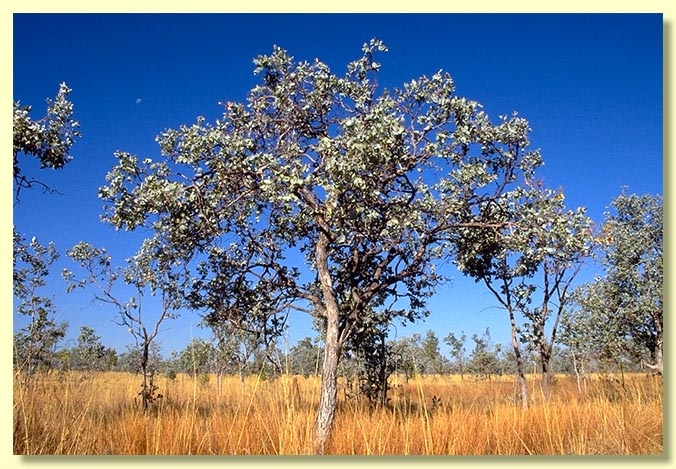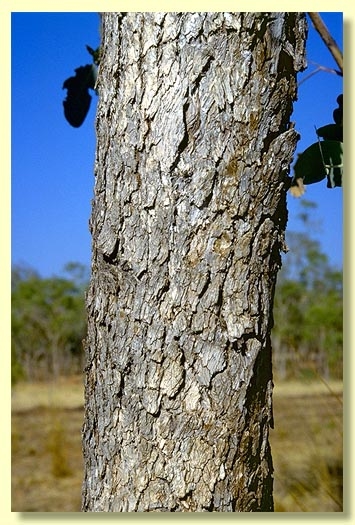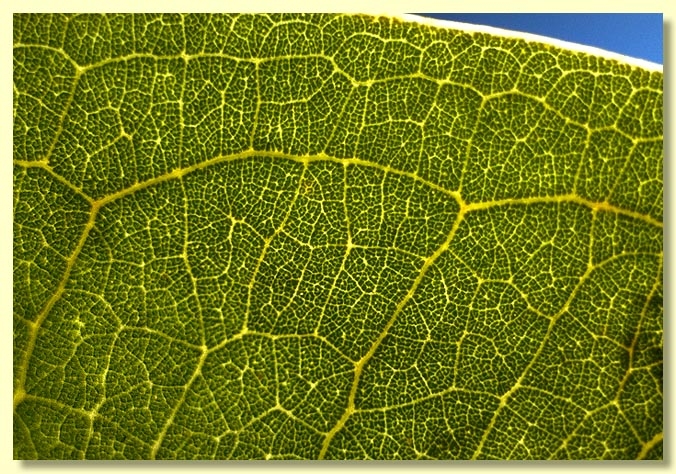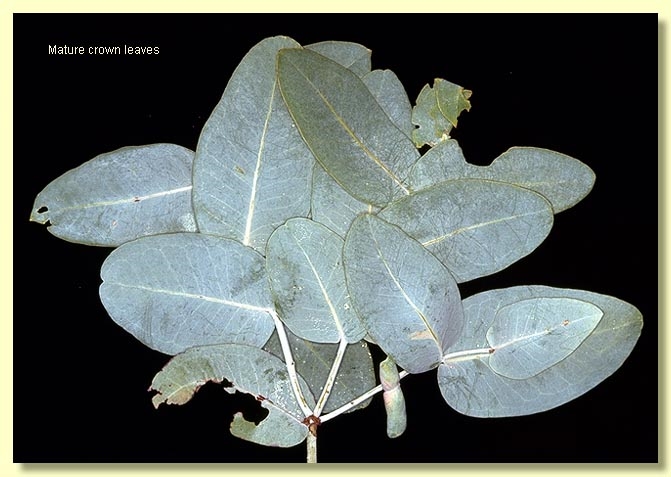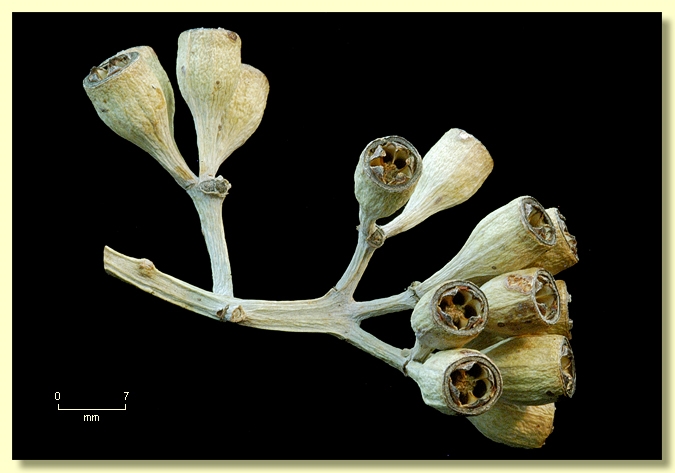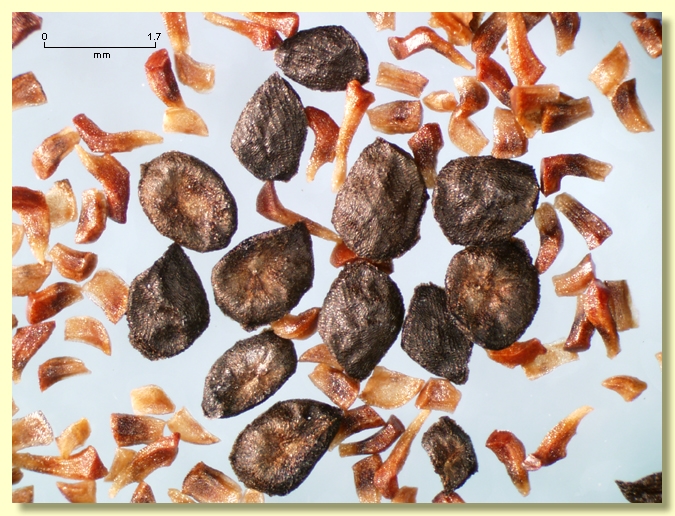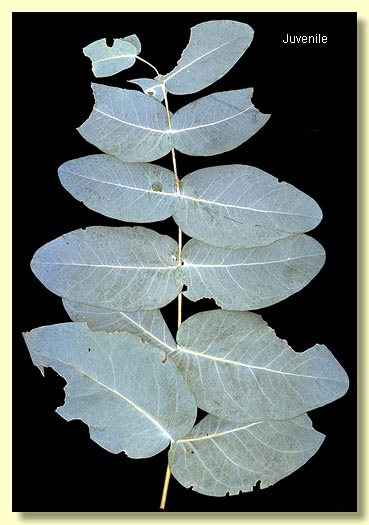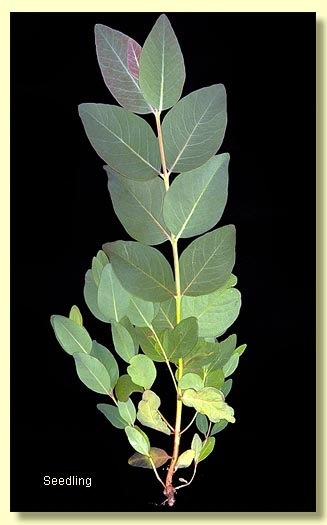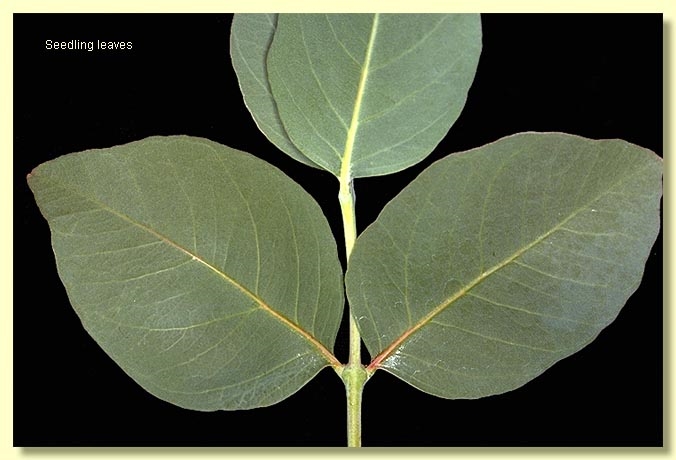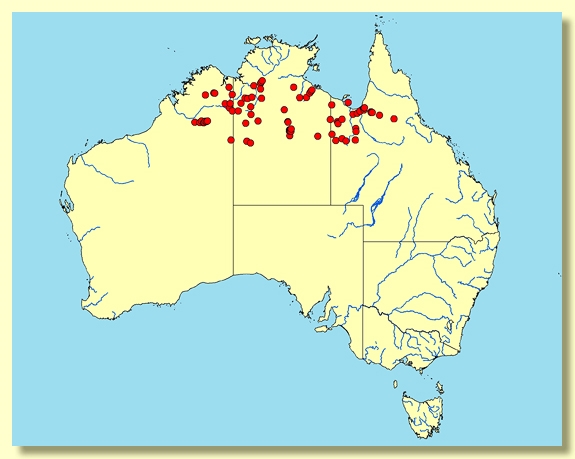Euclid - Online edition
Eucalyptus pruinosa subsp. pruinosa
Eucalyptus | Symphyomyrtus | Adnataria | Apicales | Aquilonares | Fortes
Tree to 10 m tall or a mallee. Forming a lignotuber.
Bark rough, grey, box-type extending to the small branches, flaky or firm and fissured, sometimes with wavy pattern, sometimes becoming tessellated on older trunks.
Branchlets lacking oil glands in the pith; always glaucous and square in cross-section.
Juvenile growth (coppice or field seedlings to 50 cm): stems square in cross-section and sometimes prominently winged, always glaucous; juvenile leaves opposite, sessile and amplexicaul, cordate or elliptical, (6)9–14 cm long, 6–10 cm wide, the apex rounded or pointed, rarely emarginate, glaucous.
Crown of mature tree entirely of juvenile leaves. True adult leaves not formed.
Crown leaves opposite, sessile; blade usually cordate or broadly elliptical, rarely almost orbicular, (4.5)6–16 cm long, (2.5)3.5–10.5 cm wide, flat or undulate, base usually amplexicaul, margin entire, apex rounded or pointed, concolorous, dull, glaucous, rarely green (little or no visible wax), side-veins at greater than 45° to midrib, reticulation very dense, intramarginal vein remote from margin, oil glands mostly intersectional or obscure.
Inflorescence terminal compound, peduncles rounded to angular and thickish, always > 1 mm diameter, 0.3–2.6 cm long, buds 7 per umbel, pedicellate (pedicels 0.2–1.2 cm long). Mature buds fusiform to obovoid or pyriform, 0.6–1.2 cm long, 0.3–0.5 cm wide, glaucous, scar present (outer operculum lost early), operculum beaked or conical, rarely rounded, stamens irregularly flexed, all fertile, anthers oblong, adnate, dehiscing by lateral slits, style long and straight, stigma blunt or slightly tapering, locules 4 or 5, the placentae each with 4 vertical ovule rows. Flowers creamy white to pale yellow.
Fruit pedicellate (pedicels 0.1–0.9 cm long), usually cylindrical to obconical, 0.5–1.1 cm long, 0.5–8 cm wide, glaucous or not so, disc narrow, descending, valves 4 or 5, near rim level or exserted.
Seeds blackish brown, 1.5–3 mm long, flattened-ovoid, dorsal surface smooth or shallowly reticulate, hilum ventral.
Cultivated seedlings (measured at ca node 10): cotyledons reniform; stems square to rounded in cross-section, glaucous or non-glaucous; leaves shortly petiolate (petioles to 0.4 cm), opposite for many nodes, ovate or broadly elliptic, (2.5)6–8 cm long, 2–5.2 cm wide, base rounded or tapering, apex rounded or broadly pointed, green or glaucous.
Flowering has been recorded in March, April, May, June, July, August and October.
Eucalyptus pruinosa is a small to medium-sized tree species of open savannah woodlands, or a mallee on harsher sites. It is widespread across northern Australia from the central and southern Kimberley region of Western Australia through the Northern Territory from south of Katherine to about Tennant Creek and north-east and east through Arnhem Land as far as Yirrkala and Roper River, extending to the Gulf of Carpentaria hinterland in north-western Queensland as far east as between Forsayth and Einasleigh and as far south as Dajarra. It is also known from Sweers Island in the Gulf. Eucalyptus pruinosa is easily distinguished throughout its range by the mature crown of glaucous, sessile juvenile leaves, grey box-type rough bark and buds and fruit borne at the ends of branchlets.
In the classification of Brooker (2000) Eucalyptus pruinosa belongs in Eucalyptus subgenus Symphyomyrtus section Adnataria (the boxes) because the buds have two opercula, ovules are in four rows, seeds are flattened-ovoid, cotyledons are reniform, and anthers are rigid on the staminal filaments. Within section Adnataria, E. pruinosa belongs to a subgroup of box species with tropical distribution, series Aquilonares subseries Fortes, having inflorescences terminal on the branchlets, adult leaves very densely reticulate and fruit that are firm not fragile and have valves more or less at rim level when dehisced.
Hill and Johnson (2000) divided Eucalyptus pruinosa into two subspecies:
E. pruinosa subsp. pruinosa
is distinguished by having coarser peduncles, pedicels, buds and fruit. Peduncles are > 1 mm diameter and fruit are 0.5–0.8 cm wide. It occurs in drier more southerly part of the species range from Fitzroy Crossing and near Mount House in the Kimberley region east through the Northern Territory in the upper Victoria River area, the Barkly Tableland and Macarthur River area into Queensland where it is the only subspecies found.
E. pruinosa subsp. tenuata
has more slender inflorescence parts with the peduncles about 1 mm diameter or less, buds more obviously pyriform and fruit only 0.4–0.7 cm diameter. It is distributed through the northern, wetter part of the species range, from the Kununurra and Ivanhoe area of the Kimberley region east though the Keep River area and lower Victoria River area of the Northern Territory to Katherine, north-east and east through Mainoru and the middle reaches of the Roper River to near Yirrkala.
Plants intermediate in form between these two subspecies occur occasionally in the Kimberley region particularly and in the Northern Territory.
Eucalyptus pruinosa: Latin pruina, waxy, whitish powdery 'bloom', referring to the waxy nature of the foliage and inflorescences.

